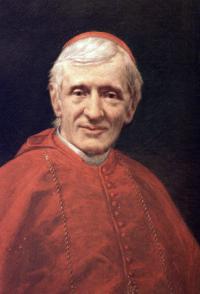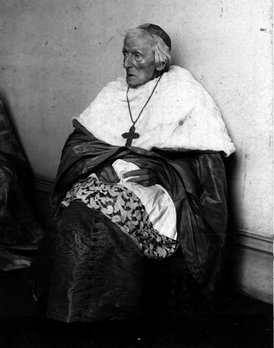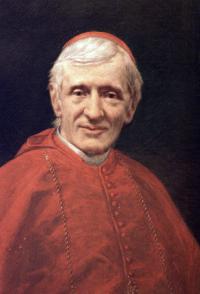 Cardinal Newman in his admirable “Letter addressed to the Rev. E. B. Pusey, D.D., on occasion of his Eirenicon” (1865) says very aptly: “Theology is occupied with supernatural matters, and is ever running into mysteries, which reason can neither explain nor adjust. Its lines of thought come to an abrupt termination, and to pursue them or to complete them is to plunge down the abyss. St. Augustine warns us that, if we attempt to find and to tie together the ends of lines which run into infinity, we shall only succeed in contradicting ourselves” (Difficulties felt by Anglicans in Catholic Teaching, 5th ed., p. 430). It is widely agreed that the ultimate considerations which determine a true estimate of all particular points of the Christian tradition are doctrinal. No purely historical arguments, whether from antiquity or from silence, are ever decisive. They are subject to a further theological scrutiny and revision in the perspective of the total Christian faith, taken as a whole. The ultimate question is simply this: does one really keep the faith of the Bible and of the Church, does one accept and recite the Catholic Creed exactly in that sense in which it had been drafted and supposed to be taken and understood, does one really believe in the truth of the Incarnation?
Cardinal Newman in his admirable “Letter addressed to the Rev. E. B. Pusey, D.D., on occasion of his Eirenicon” (1865) says very aptly: “Theology is occupied with supernatural matters, and is ever running into mysteries, which reason can neither explain nor adjust. Its lines of thought come to an abrupt termination, and to pursue them or to complete them is to plunge down the abyss. St. Augustine warns us that, if we attempt to find and to tie together the ends of lines which run into infinity, we shall only succeed in contradicting ourselves” (Difficulties felt by Anglicans in Catholic Teaching, 5th ed., p. 430). It is widely agreed that the ultimate considerations which determine a true estimate of all particular points of the Christian tradition are doctrinal. No purely historical arguments, whether from antiquity or from silence, are ever decisive. They are subject to a further theological scrutiny and revision in the perspective of the total Christian faith, taken as a whole. The ultimate question is simply this: does one really keep the faith of the Bible and of the Church, does one accept and recite the Catholic Creed exactly in that sense in which it had been drafted and supposed to be taken and understood, does one really believe in the truth of the Incarnation?
Let me quote Newman once more. “I say then,” he proceeds, “when once we have mastered the idea, that Mary bore, suckled, and handled the Eternal in the form of a child, what limit is conceivable to the rush and flood of thoughts which such a doctrine involves? What awe and surprise must attend upon the knowledge, that a creature has been brought so close to the Divine Essence?” (op. cit., page 431). Fortunately, a Catholic theologian is not left alone with logic and erudition. He is led by the faith; credo ut intelligam. Faith illuminates the reason. And erudition, the memory of the past, is quickened in the continuous experience of the Church.
A Catholic theologian is guided by the teaching authority of the Church, by its living tradition. But above all, he himself lives in the Church, which is the Body of Christ. The mystery of the Incarnation is still, as it were, continuously enacted in the Church, and its “implications” are revealed and disclosed in devotional experience and in sacramental participation. In the Communion of Saints, which is the true Church Universal and Catholic, the mystery of the New Humanity is disclosed as a new existential situation. And in this perspective and living context of the Mystical Body of Christ the person of the Blessed Virgin Mother appears in full light and full glory. The Church now contemplates her in the state of perfection. She is now seen as inseparably united with her Son, who “sitteth on the right hand of God the Father Almighty.” For her the final consummation of life has already come-in an anticipation. “Thou art passed over into Life, who art the Mother of Life,” acknowledges the Church, “Neither grave nor death had power over the Mother of God… for the Mother of Life hath been brought into Life by him who dwelt in her ever-virgin womb” (Troparion and Kontakion for the feast of the Assumption of the Virgin Mary).
Again, it is not so much a heavenly reward for her purity and virtue, as an “implication” of her sublime office, of her being the Mother of God, the Theotokos. The Church Triumphant is above all the worshipping Church, her existence is a living participation in Christ’s office of intercession and his redeeming love. Incorporation into Christ, which is the essence of the Church and of the whole Christian existence, is first of all an incorporation into his sacrificial love for mankind. And here there is a special place for her who is united with the Redeemer in the unique intimacy of motherly affection and devotion. The Mother of God is truly the common mother of all living, of the whole Christian race, born or reborn in the Spirit and truth. An affectionate identification with the child, which is the spiritual essence of motherhood, is here consummated in its ultimate perfection. The Church does not dogmatize much about these mysteries of her own existence. For the mystery of Mary is precisely the mystery of the Church. Mater Ecclesia and Virgo Alater, both are birthgivers of the New Life. And both are orantes.
The Church invites the faithful and helps them to grow spiritually into these mysteries of faith which are as well the mysteries of their own existence and spiritual destiny. In the Church they learn to contemplate and to adore the living Christ together with the whole assembly and Church of the firstborn, which are written in heaven (Heb. 12:23). And in this glorious assembly they discern the eminent person of the Virgin Mother of the Lord and Redeemer, full of grace and love, of charity and compassion — “More honorable than the cherubim, more glorious than the seraphim, who without spot didst bear the Eternal Word.” In the light of this contemplation and in the spirit of faith the theologian must fulfill his office of interpreting to believers and to those who seek the truth the overwhelming mystery of the Incarnation. This mystery is still symbolized, as it was in the age of the Fathers, by a single and glorious name: Mary Theotokos, the Mother of God Incarnate.
The Ever-Virgin Mother of God
Archpriest George Florovsky




